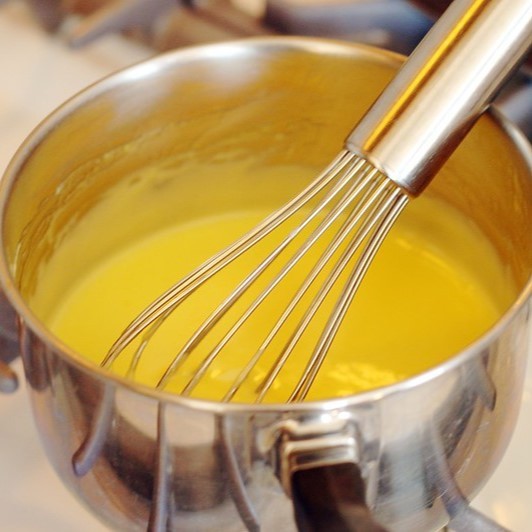Hollandaise
"Hollandaise Sauce" by Stacy Spensley is licensed under CC BY 2.0 .
Servings: 2 per method
A serving is roughly the amount of sauce needed for two eggs benedicts (1 English muffin, 2 slices canadian bacon, 2 poached eggs).
Notes:
- Hollandaise, like nearly every other sauce, will tighten when cooled, meaning it will become thicker. Hollandaise is a sauce that should be nappe consistency when made correctly.
- If your hollandaise seems too thick, vigorously whisk in a tablespoon of hot water at a time until the sauce becomes the consistency you want.
- If your hollandaise seems too thin, apply additional heat with constant whisking until it becomes the consistency you want. However, remember that hollandaise will "tighten" when cooling, so you can over thicken it very easily.
- Hollandaise doesn't keep well. You should make it as close to the time that you want to eat it as possible. If you do want to save it, store it with plastic wrap pressed onto the surface, and gently reheat using a double boiler or very low power in the microwave with very frequent mixing.
- Hollandaise likes to break, meaning the fat and water will stop being bound together (aka emmulsified). If it breaks and looks oily, add a tablespoon of hot water and whisk until the sauce comes back together.
- The classic-ish method is the most difficult and fussy of the three methods.
- The blender method is probably the best balance between quality, effort (having the smallest of the three methods), and cleanup (basically only needing to wash the blender and the bowl/pan you heated the butter in).
- The microwave method is best if you don't have a blender and don't want to whisk for 10 minutes.
Classic-ish Method
Ingredients
- 2 Egg yolks (save the egg whites - they freeze well)
- 2 Tablespoons water
- 1 Tablespoon lemon juice
- 8 Tablespoons of butter, cut into 1/4 tablespoon pieces
- A pinch of salt
- A pinch of cayenne pepper
Directions
- Place egg yolks, water, and lemon juice to a small pot; with no heat, whisk until the mixture is smooth.
- Add butter to mixture.
- Place the pot on medium-low heat and continuously whisk the mixture until it thickens to the consistency of gravy. Do not stop whisking and be very thorough with scraping every surface of the pot as the eggs will curdle if allowed to rest on the pot.
- Immediately remove from heat and add a pinch of salt and cayenne pepper. Stir, taste, and adjust seasoning as needed.
Blender Method
Ingredients
- 2 Egg yolks (save the egg whites - they freeze well)
- 1 Tablespoon lemon juice
- 1/4 Teaspoon Dijon mustard
- 8 Tablespoons of butter, heated until melted and very hot (but NOT browned)
- A pinch of salt
- A pinch of cayenne pepper
Directions
- Add egg yolks, and lemon juice to blender.
- Turn the blender on and slowly stream in the very hot melted butter. Blend until the sauce is completely smooth, about 30 seconds.
- Add salt and cayenne. Stir, taste, and adjust seasoning as needed.
Microwave Method
Ingredients
- 2 Egg yolks (save the egg whites - they freeze well)
- 1 Tablespoon lemon juice
- 4 Tablespoons of butter, melted
- A pinch of salt
- A pinch of cayenne pepper
Directions
- Combine egg yolks and lemon juice in a bowl. Whisk until the mixture is smooth.
- Slowly stream in the butter mixture, whisking vigourously until the butter has been incorporated.
- Heat sauce in microwave for 5 seconds and then whisk very thoroughly.
- Reapeat heating and whisking until the sauce has thickened to your liking. Note that the sauce will tighten as it cools.
- Add salt and cayenne. Stir, taste, and adjust seasoning as needed.


No Comments